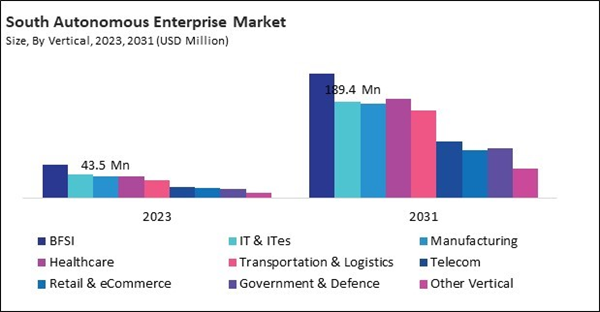The Latin America, Middle East and Africa Autonomous Enterprise Market is expected to witness market growth of 20.0% CAGR during the forecast period (2024-2031).
The Brazil market dominated the LAMEA Autonomous Enterprise Market by Country in 2023, and is expected to continue to be a dominant market till 2031; thereby, achieving a market value of USD3.09 billion by 2031. The Argentina market is showcasing a CAGR of 20.8% during 2024-2031. Additionally, the UAE market would register a CAGR of 19% during 2024-2031.
This market is also being influenced by evolving customer expectations. In an era in which consumers expect immediate gratification, it is imperative that businesses are capable of promptly and effectively accommodating customer requirements. These enterprises are well-positioned to meet these expectations, as AI-driven customer service tools and automated marketing campaigns enable companies to provide personalized, real-time interactions.
Advances in robotics and autonomous systems, particularly when combined with AI, are reshaping the automation landscape across various industries. According to the IBF, in 2022, a record 553,052 industrial robots were installed. In manufacturing, robots are deployed to autonomously handle assembly, quality inspection, and predictive maintenance tasks. These systems can work around the clock, increasing productivity and reducing operational downtime.
The Brazilian telecoms industry is expanding its use of these enterprise solutions at a rapid pace in order to meet the growing need for improved network administration and customer service. The National Broadband Plan (Plano Nacional de Banda Larga), implemented by the Brazilian government, has provided significant support for expanding 5G networks, which are crucial for deploying AI-driven automation in telecom. The Ministry of Communications has been driving this transformation, bringing autonomous technologies to telecom companies to reduce operational costs and enhance service quality. Therefore, all these factors will support the growth of the regional autonomous enterprise market.
Based on Offering, the market is segmented into Solution (Robotic Process Automation, Autonomous Networks, Accounts Automation & Security Automation, and Autonomous Agents & Others) and Services (Professional Services and Managed Services). Based on Business Functions, the market is segmented into Sales & Marketing, Accounting & Finance, Supply Chain & Operations, Human Resource (HR), and IT.
The Brazil market dominated the LAMEA Autonomous Enterprise Market by Country in 2023, and is expected to continue to be a dominant market till 2031; thereby, achieving a market value of USD3.09 billion by 2031. The Argentina market is showcasing a CAGR of 20.8% during 2024-2031. Additionally, the UAE market would register a CAGR of 19% during 2024-2031.
This market is also being influenced by evolving customer expectations. In an era in which consumers expect immediate gratification, it is imperative that businesses are capable of promptly and effectively accommodating customer requirements. These enterprises are well-positioned to meet these expectations, as AI-driven customer service tools and automated marketing campaigns enable companies to provide personalized, real-time interactions.
Advances in robotics and autonomous systems, particularly when combined with AI, are reshaping the automation landscape across various industries. According to the IBF, in 2022, a record 553,052 industrial robots were installed. In manufacturing, robots are deployed to autonomously handle assembly, quality inspection, and predictive maintenance tasks. These systems can work around the clock, increasing productivity and reducing operational downtime.
The Brazilian telecoms industry is expanding its use of these enterprise solutions at a rapid pace in order to meet the growing need for improved network administration and customer service. The National Broadband Plan (Plano Nacional de Banda Larga), implemented by the Brazilian government, has provided significant support for expanding 5G networks, which are crucial for deploying AI-driven automation in telecom. The Ministry of Communications has been driving this transformation, bringing autonomous technologies to telecom companies to reduce operational costs and enhance service quality. Therefore, all these factors will support the growth of the regional autonomous enterprise market.
Based on Offering, the market is segmented into Solution (Robotic Process Automation, Autonomous Networks, Accounts Automation & Security Automation, and Autonomous Agents & Others) and Services (Professional Services and Managed Services). Based on Business Functions, the market is segmented into Sales & Marketing, Accounting & Finance, Supply Chain & Operations, Human Resource (HR), and IT.
List of Key Companies Profiled
- Microsoft Corporation
- IBM Corporation
- Amazon Web Services, Inc. (Amazon.com, Inc.)
- Check Point Software Technologies Ltd.
- Pegasystems Inc.
- Cisco Systems, Inc.
- Hewlett Packard Enterprise Company
- SAP SE
- ATOSS Software SE
- Oracle Corporation
Market Report Segmentation
By Offering
- Solution
- Robotic Process Automation
- Autonomous Networks
- Accounts Automation & Security Automation
- Autonomous Agents & Others
- Services
- Professional Services
- Managed Services
By Business Functions
- Sales & Marketing
- Accounting & Finance
- Supply Chain & Operations
- Human Resource (HR)
- IT
By Application
- Process Automation
- Customer & Employee Engagement
- Order Management
- Credit Evaluation & Management
- Predictive Maintenance
- Other Application
By Vertical
- BFSI
- IT & ITes
- Manufacturing
- Healthcare
- Transportation & Logistics
- Telecom
- Retail & eCommerce
- Government & Defence
- Other Vertical
By Country
- Brazil
- Argentina
- UAE
- Saudi Arabia
- South Africa
- Nigeria
- Rest of LAMEA
Table of Contents
Chapter 1. Market Scope & Methodology
Chapter 2. Market at a Glance
Chapter 3. Market Overview
Chapter 4. Competition Analysis - Global
Chapter 5. LAMEA Autonomous Enterprise Market by Offering
Chapter 6. LAMEA Autonomous Enterprise Market by Business Functions
Chapter 7. LAMEA Autonomous Enterprise Market by Application
Chapter 8. LAMEA Autonomous Enterprise Market by Vertical
Chapter 9. LAMEA Autonomous Enterprise Market by Country
Chapter 10. Company Profiles
Companies Mentioned
Some of the key companies in the LAMEA Autonomous Enterprise Market include:- Microsoft Corporation
- IBM Corporation
- Amazon Web Services, Inc. (Amazon.com, Inc.)
- Check Point Software Technologies Ltd.
- Pegasystems Inc.
- Cisco Systems, Inc.
- Hewlett Packard Enterprise Company
- SAP SE
- ATOSS Software SE
- Oracle Corporation
Methodology

LOADING...









